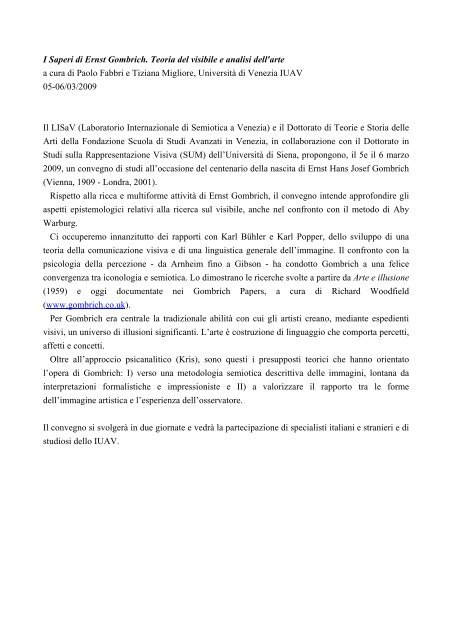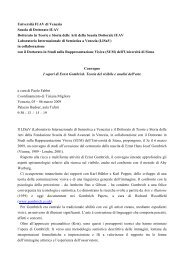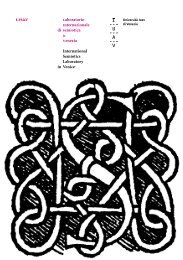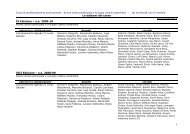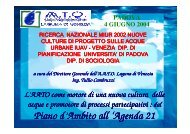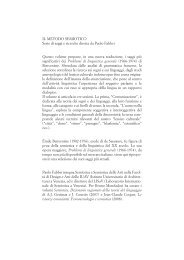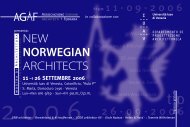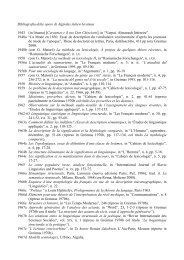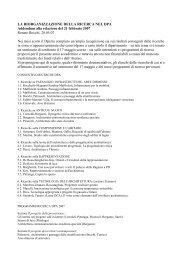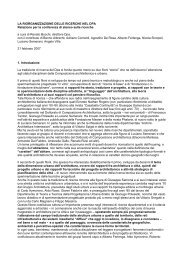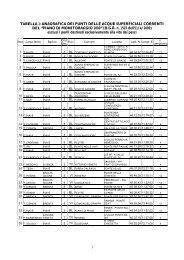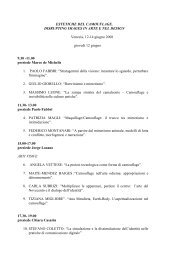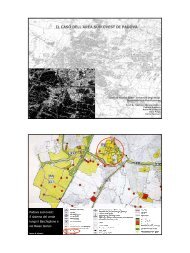I Saperi di Ernst Gombrich. Teoria del visibile e analisi dell'arte a ...
I Saperi di Ernst Gombrich. Teoria del visibile e analisi dell'arte a ...
I Saperi di Ernst Gombrich. Teoria del visibile e analisi dell'arte a ...
Create successful ePaper yourself
Turn your PDF publications into a flip-book with our unique Google optimized e-Paper software.
I <strong>Saperi</strong> <strong>di</strong> <strong>Ernst</strong> <strong>Gombrich</strong>. <strong>Teoria</strong> <strong>del</strong> <strong>visibile</strong> e <strong>analisi</strong> <strong>del</strong>l'arte<br />
a cura <strong>di</strong> Paolo Fabbri e Tiziana Migliore, Università <strong>di</strong> Venezia IUAV<br />
05-06/03/2009<br />
Il LISaV (Laboratorio Internazionale <strong>di</strong> Semiotica a Venezia) e il Dottorato <strong>di</strong> Teorie e Storia <strong>del</strong>le<br />
Arti <strong>del</strong>la Fondazione Scuola <strong>di</strong> Stu<strong>di</strong> Avanzati in Venezia, in collaborazione con il Dottorato in<br />
Stu<strong>di</strong> sulla Rappresentazione Visiva (SUM) <strong>del</strong>l’Università <strong>di</strong> Siena, propongono, il 5e il 6 marzo<br />
2009, un convegno <strong>di</strong> stu<strong>di</strong> all’occasione <strong>del</strong> centenario <strong>del</strong>la nascita <strong>di</strong> <strong>Ernst</strong> Hans Josef <strong>Gombrich</strong><br />
(Vienna, 1909 - Londra, 2001).<br />
Rispetto alla ricca e multiforme attività <strong>di</strong> <strong>Ernst</strong> <strong>Gombrich</strong>, il convegno intende approfon<strong>di</strong>re gli<br />
aspetti epistemologici relativi alla ricerca sul <strong>visibile</strong>, anche nel confronto con il metodo <strong>di</strong> Aby<br />
Warburg.<br />
Ci occuperemo innanzitutto dei rapporti con Karl Bühler e Karl Popper, <strong>del</strong>lo sviluppo <strong>di</strong> una<br />
teoria <strong>del</strong>la comunicazione visiva e <strong>di</strong> una linguistica generale <strong>del</strong>l’immagine. Il confronto con la<br />
psicologia <strong>del</strong>la percezione - da Arnheim fino a Gibson - ha condotto <strong>Gombrich</strong> a una felice<br />
convergenza tra iconologia e semiotica. Lo <strong>di</strong>mostrano le ricerche svolte a partire da Arte e illusione<br />
(1959) e oggi documentate nei <strong>Gombrich</strong> Papers, a cura <strong>di</strong> Richard Woodfield<br />
(www.gombrich.co.uk).<br />
Per <strong>Gombrich</strong> era centrale la tra<strong>di</strong>zionale abilità con cui gli artisti creano, me<strong>di</strong>ante espe<strong>di</strong>enti<br />
visivi, un universo <strong>di</strong> illusioni significanti. L’arte è costruzione <strong>di</strong> linguaggio che comporta percetti,<br />
affetti e concetti.<br />
Oltre all’approccio psicanalitico (Kris), sono questi i presupposti teorici che hanno orientato<br />
l’opera <strong>di</strong> <strong>Gombrich</strong>: I) verso una metodologia semiotica descrittiva <strong>del</strong>le immagini, lontana da<br />
interpretazioni formalistiche e impressioniste e II) a valorizzare il rapporto tra le forme<br />
<strong>del</strong>l’immagine artistica e l’esperienza <strong>del</strong>l’osservatore.<br />
Il convegno si svolgerà in due giornate e vedrà la partecipazione <strong>di</strong> specialisti italiani e stranieri e <strong>di</strong><br />
stu<strong>di</strong>osi <strong>del</strong>lo IUAV.
I <strong>Saperi</strong> <strong>di</strong> <strong>Ernst</strong> <strong>Gombrich</strong>. <strong>Teoria</strong> <strong>del</strong> <strong>visibile</strong> e <strong>analisi</strong> <strong>del</strong>l'arte<br />
Paolo Fabbri e Tiziana Migliore, Venice University IUAV<br />
05-06/03/2009<br />
The LISaV (International Semiotic Laboratory in Venice) and the PhD Program in History and<br />
Theory of the Arts of the School for Advanced Stu<strong>di</strong>es of Venice, in collaboration with the PhD<br />
Program in Visual Stu<strong>di</strong>es of Siena University (SUM), are organizing a Colloquium about <strong>Ernst</strong><br />
Hans Josef <strong>Gombrich</strong> (Wien, 1909 – London, 2001), that should be held on March 5-6 2009 in<br />
Venice.<br />
The aim of the Colloquium is to investigate some specific issues among the multifarious activities<br />
and interests of <strong>Ernst</strong> <strong>Gombrich</strong>, in order to mainly focus on the epistemological aspects related to<br />
his theory of the image, also comparing it with Aby Warburg’s approach to art history.<br />
The Colloquium will then consider the relations between <strong>Ernst</strong> <strong>Gombrich</strong>, Karl Bühler and Karl<br />
Popper and analyse the development of a theory of visual communication, with particular regard to<br />
a Visual Linguistics.<br />
The <strong>di</strong>alectical exchange with the psychology of perception – from Arnheim to Gibson – lead<br />
<strong>Gombrich</strong> to a productive convergence of iconology and semiotics. This is shown by the researches<br />
carried out by <strong>Gombrich</strong> since Art and Illusion (1959) and today it is witnessed by the <strong>Gombrich</strong><br />
Papers, e<strong>di</strong>ted by Richard Woodfield (www.gombrich.co.uk).<br />
<strong>Gombrich</strong>’s key issue regarded the tra<strong>di</strong>tional ability with which artists create, through visual<br />
devices, a universe of meaningful illusions. Art is then illusion since it is a construction of a<br />
language.<br />
Together with a psychoanalytical approach instigated by <strong>Ernst</strong> Kris, these are the theoretical<br />
assumptions that addressed <strong>Gombrich</strong> toward 1) a semiotic methodology to describe pictures,<br />
<strong>di</strong>fferent from formalistic or impressionist interpretations and 2) a valorisation of the relation<br />
between the artistic image and the experience of the viewer.<br />
The Colloquium will take place in two days, during which international and Italian scholars, mainly<br />
from the IUAV University of Venice, will <strong>di</strong>scuss about the abovementioned issues.
Bernard Aikema (Università <strong>di</strong> Verona)<br />
Giuseppe Barbieri (Università <strong>di</strong> Venezia Ca' Foscari)<br />
Donatella Calabi (IUAV)<br />
Omar Calabrese (Università <strong>di</strong> Siena)<br />
Francesca Castellani (IUAV)<br />
Serena Cattaruzza (Università <strong>di</strong> Trieste)<br />
Lucia Corrain (Università <strong>di</strong> Bologna)<br />
Stefano Ferrari (Università <strong>di</strong> Bologna)<br />
Paolo Legrenzi (IUAV)<br />
Joaquin Lorda (Università <strong>di</strong> Navarra)<br />
Gianfranco Marrone (Università <strong>di</strong> Palermo)<br />
Carlo Severi (IUAV)<br />
Victor I. Stoichita (Università <strong>di</strong> Friburgo)<br />
Richard Woodfield (Università <strong>di</strong> Nottingham Trent) LINGUA INGLESE<br />
bernardjanhendrik.aikema@univr.it , useppebarbieri@gmail.com ,<br />
calabi@iuav.it , omar.calabrese@unisi.it , <strong>di</strong>liget@fastwebnet.it ,<br />
serena.cattaruzza@tin.it , lucia.corrain@unibo.it ,<br />
stefano.ferrari@unibo.it , legrenzi@iuav.it , jlorda@unav.es ,<br />
gmarrone@fastwebnet.it , Carlo.Severi@ehess.fr ,<br />
victor.stoichita@unifr.ch<br />
, richard.woodfield@ntlworld.com


